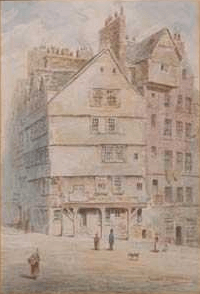James Baynes facts for kids
James Baynes (born April 5, 1766 – died May 12, 1837) was an English artist. He was known for his beautiful watercolour paintings. He also worked as a drawing teacher.
Contents
Early Life and Art Training
James Baynes was born in Lancaster. His father was a local businessman. James was the oldest of six children. From a young age, he loved art and drawing. A local doctor, Dr. Campbell, noticed James's talent. Dr. Campbell sent some of James's drawings to his friend, the famous painter George Romney. Because of this, young James Baynes was sent to London. He got to study art under Romney, with Dr. Campbell paying for his lessons.
In 1784, when James was 18, he became a student at the Royal Academy. This was a big step for a young artist.
Family Life and Challenges
In 1785, James Baynes married Mary Mann (1766–1845) in London. Their son, Thomas Mann Baynes (1794–1854), also became a well-known watercolour artist.
However, James married without Dr. Campbell's permission. This meant he lost Dr. Campbell's support. He also missed out on a chance to travel and study art in Italy. James had to find work on his own. He found a job with the Polygraphic Society. This company made copies of famous paintings. They would touch up the copies by hand and then sell them. James earned £100 a year for this work.
When the company failed, James moved homes several times in London. He finally settled at 73 Castle Street, near Oxford Street. He lived there for 40 years until he passed away.
A Dedicated Teacher and Artist
James Baynes spent a lot of his time teaching drawing. He was very good at it and had many students. He also worked for architects, like Sir Jeffry Wyattville. Some of his famous students included John Wood, Sir Henry Sass, and J.D. Harding. Sass later started his own art school. Harding became a famous landscape painter. He also helped improve lithography, a type of printing.
Even with a busy teaching schedule and eight children, James kept painting. He often showed his watercolour paintings at the Royal Academy between 1796 and 1837. Sometimes, he also showed oil paintings. He loved to paint landscapes from places like Norfolk, North Wales, Cumberland, and Kent. He often added figures and animals to his scenes.
Faith and Travels
James Baynes and his wife were members of the Sandemanian Church. This was a small, close-knit Christian group. In London, the famous scientist Michael Faraday was also a leader in this church. James joined the London church in 1792.
James Baynes loved to travel around England and Wales to draw landscapes. His sketchbooks show his journeys. He visited the South of England in 1802. He went to Wales and the West of England in 1810. In 1815, he explored Cumberland, and in 1816, he visited Kent.
James Baynes passed away on May 12, 1837, due to a heart problem. Both he and his wife, Mary, are buried in St. Johns Wood Cemetery in London.
Famous Works
Here are some of James Baynes's notable artworks:
- The Well in Carisbrook Castle (ink and wash drawing)
- Castle Ruins with Figures (watercolour on paper)
- Caernarvon Castle across the River (watercolour on paper)
- City Street Corner Scene with Figures (watercolour on paper)
- Figures on a Lakeland Track (watercolour on paper)


